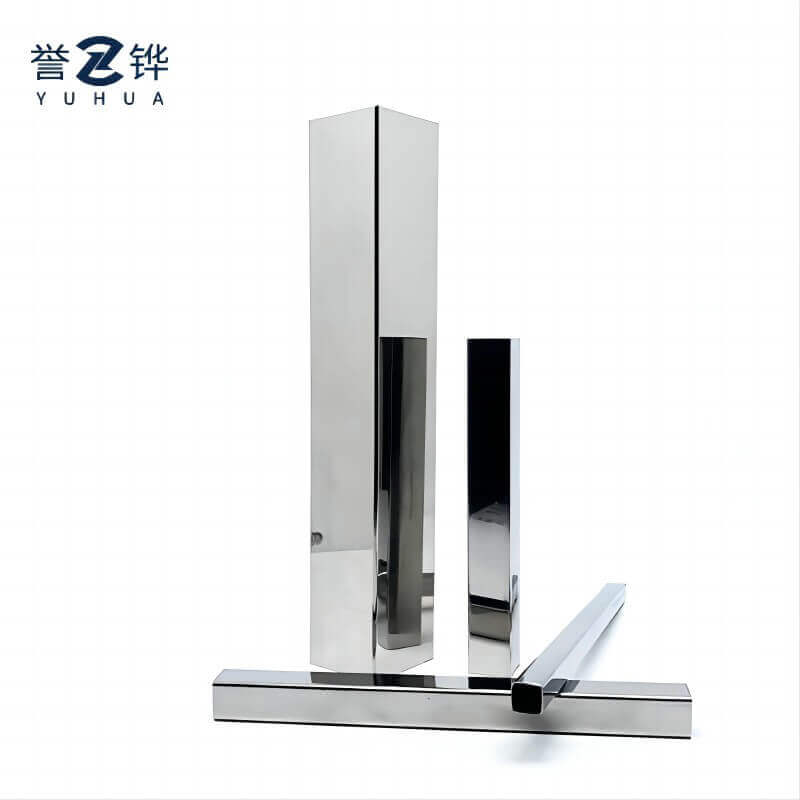Stainless square tubes are hollow, long metal strips with a square shape, dishing out a dope mix of toughness and versatility. Because the cross-section is square, it is called square pipe. They’re usually whipped up from rust-proof stainless steel grades like 304 and 316, loaded with chromium and nickel. enabling them to fend off rust and stay burly.
One massive reason stainless steel square pipes are a total win in industrial spots is they don’t rust or get munched by chemicals.
These tubes are hard as nails but still light enough to keep things practical, making them killer for structures that gotta hold weight without being a beast. It is widely used as a pipeline for transporting fluids, such as oil, natural gas, water, gas, steam, etc., and is also widely used in the manufacture of mechanical parts and engineering structures because it is lighter in weight when it has the same bending and torsional strength.
Stainless steel’s got this slick, metallic glow that looks rad in building designs, and its smooth surface is crazy easy to wipe down, which is huge in spots like food processing or pharma setups. Stainless steel has a metallic luster, beautiful appearance, suitable for decoration and other fields.

Stainless square tube sizes come in a bazillion options to fit all kinds of industrial gigs. The dimensions of them are typically defined by three key parameters: outer diameter, wall thickness and length.
| Parameter Category | Common Standard Range | Notes & Common Examples |
| Outer Size (OD) | 10mm x 10mm to 200mm x 200mm and above | Common Small Sizes: 20x20mm, 25x25mm, 30x30mm (Often used for decoration, furniture) Common Large Sizes: 50x50mm, 100x100mm (Often used for mechanical structures, load-bearing) |
| Wall Thickness | 0.5mm to 6.0mm and thicker | Common Thin Wall: 0.5mm, 0.8mm, 1.0mm (For light loads and decoration) Common Thick Wall: 1.5mm, 2.0mm, 3.0mm (For structural applications requiring strength) |
| Length | Standard fixed length is typically 6 meters | Custom lengths are also available based on requirements, such as 1m, 3m, 5m, or other non-standard lengths. |
Bigger tubes with thicker walls are dope for heavy-duty jobs since they’re super strong. Smaller, thinner tubes are cool for stuff like furniture frames or indoor railings where there’s less pressure.
In fluid systems, the inner size of the tube calls the shots on how much can flow. Bigger tubes handle more juice but take up more room and cost a bit.
Smaller square tubes are the bomb for tight construction spaces compared to round or rectangular ones. Engineers often grab smaller stainless square tube sizes for modular setups.
For building stuff, wall thickness and strength are the big players. For fluid systems, the inner size messes with how smooth things flow.
If your project’s dealing with nasty stuff, you might want a beefier grade like 316 over 304. Still, grade 304 stainless steel offers superior corrosion resistance and durability in most chill settings.
You gotta play the cost game smart. Thicker walls hit the wallet harder because of extra material but can save you dough on fixes later thanks to their toughness.
Thin-walled tubes are light, easy to move, and cheaper but might not have the guts for heavy jobs. Thick-walled tubes are mega sturdy but jack up the cost and weight.
Standards keep things tight and safe. Check for full compliance with ASTM A554, EN 10296-2 standards, which ensures that the stainless steel square pipe you choose meets international quality benchmarks.
Digital calipers nail outer measurements like a champ. Micrometers are clutch for checking wall thickness. Go/no-go gauges let you zip through checking if tolerances are on point during inspections.
Getting tolerances helps make sure parts fit like a glove. For example, Outer Dimensions 20mm x 20mm (±0.13mm tolerance) shows the wiggle room in making tubes that won’t screw up performance.
Picking a tube too big blows cash and adds weight, while too small can lead to wipeouts or safety messes if it’s not strong enough or can’t handle the flow.
Wrong sizes can tank pressure in fluid systems or make structures wobble under load, which could cause total flops or legal drama.

At YUHUA, we’re all about pumping out top-shelf stainless steel square pipe products that hit hardcore industry standards. Our offerings include 1.5 Meter 20x20mm 304 Stainless Steel Square Tube Annealed Surface Corrosion Resistant Metal Pipe known for their precision engineering.
We’ve got a ton of sizes and finishes for stuff like furniture making, industrial machines, building structures, and decorative projects. Our stainless square tube sizes range from small-scale options for interior design to heavy-duty variants for industrial infrastructure.
All our tubes are fully compliant with ASTM A554, EN 10296-2 standards, undergo eddy current testing for weld integrity, and come with mill test certificates ensuring complete traceability.
We can crank out custom lengths, wall thicknesses, and finishes. Whether you need annealed surfaces for slick polish or thicker walls for beefy structures, our engineering crew can hook you up.

Q: What’s the difference between 304 and 316 stainless square tubing?
A: The big difference is rust resistance; 316 has molybdenum, which gives extra shield against stuff like chlorides and acids compared to 304.
Q: How do I figure out the right wall thickness of stainless square tubes for my project?
A: Think about load needs, environmental exposure, and fluid flow if it applies. Heavier loads need thicker walls; gnarly settings might nudge your pick too.
Q: Can stainless square tubes be cut or welded easy?
A: Heck yeah. Especially those with an annealed surface finish, which makes welding and fabrication a snap. Just use the right tools and safety gear when you’re at it.